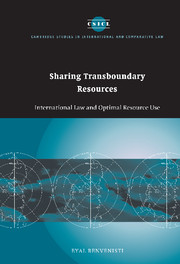Book contents
- Frontmatter
- Contents
- Acknowledgments
- Table of cases
- List of abbreviations
- 1 Introduction
- 2 The need for collective action in the management of transboundary resources
- 3 States as collective actors
- 4 The transnational conflict paradigm: structural failures and responses
- 5 Transnational institutions for transboundary ecosystem management: defining the tasks and the constraints
- 6 The structure and procedure of institutions for transboundary ecosystem management
- 7 The development of positive international law on transboundary ecosystems: a critical analysis
- 8 Efficiency, custom, and the evolution of international law on transboundary resources
- 9 Conclusion
- Bibliograhy
- Index
- CAMBRIDGE STUDIES IN INTERNATIONAL AND COMPARATIVE LAW
2 - The need for collective action in the management of transboundary resources
Published online by Cambridge University Press: 14 July 2009
- Frontmatter
- Contents
- Acknowledgments
- Table of cases
- List of abbreviations
- 1 Introduction
- 2 The need for collective action in the management of transboundary resources
- 3 States as collective actors
- 4 The transnational conflict paradigm: structural failures and responses
- 5 Transnational institutions for transboundary ecosystem management: defining the tasks and the constraints
- 6 The structure and procedure of institutions for transboundary ecosystem management
- 7 The development of positive international law on transboundary ecosystems: a critical analysis
- 8 Efficiency, custom, and the evolution of international law on transboundary resources
- 9 Conclusion
- Bibliograhy
- Index
- CAMBRIDGE STUDIES IN INTERNATIONAL AND COMPARATIVE LAW
Summary
Sovereignty, political borders and transboundary commons: the ingredients of tragedies
The two basic building blocks of the global political and legal environment – the concept of sovereignty and the allocation of jurisdiction by political borders – have joined forces to preclude an efficient and sustainable use of transboundary resources ever since the global environmental crisis emerged towards the middle of the twentieth century. By that time, the idea of national sovereignty had reached its zenith. Decolonization and other secessionist movements were vying for equal sovereign status and the unfettered discretion it promised for the management of national resources.
The concept of sovereignty implied a legal environment of unencumbered national control over the resources found within national jurisdiction. The international legal environment was based on what may be called “the Lotus principle,” namely, the underlying freedom of states to do whatever is not proven to be prohibited under international law. In other words, a world in which “Restrictions upon the independence of States cannot be presumed.” The Lotus principle, enunciated by the Permanent Court of International Justice in 1927 provided that sovereigns were free to dispose of the resources under their jurisdiction at their pleasure, unless a contrary international norm were proved. Until such a norm is proved, a polluter has to be bought off to curb emissions. A heavy water user would have to be similarly remunerated for forgoing its use. The Lotus principle, then, could be regarded as epitomizing an optimistic belief in the international invisible hand.
- Type
- Chapter
- Information
- Sharing Transboundary ResourcesInternational Law and Optimal Resource Use, pp. 22 - 42Publisher: Cambridge University PressPrint publication year: 2002



